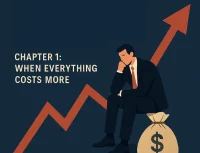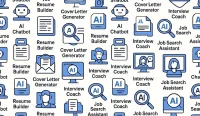AI can be a force multiplier across your search: clarifying targeting, sharpening your resume, speeding tailoring, and preparing for interviews. It backfires when you outsource judgment and voice. Use AI for assistance—not authorship—and you’ll move faster while still sounding like you.
Use AI To Enhance, Not Replace, Your Resume
Don’t paste an AI‑written resume verbatim. Recruiters and filters can spot generic, over‑polished language. Instead, draft your own impact bullets (outcome → metric → how) and use AI to help when you’re stuck—combine redundant bullets, punch up clarity, or suggest stronger verbs. Keep your voice and facts.
For tailoring, tools like Teal and Jobscan can map your resume to a job description and surface relevant keywords. Useful—but treat scores lightly. Many JDs are outdated or incomplete; if you strip out key achievements to chase a score, you risk losing interviews for roles that need unlisted experience. Embed only true, role‑relevant keywords inside outcome bullets.
Cover Letters: Customize Briefly, Keep It Human
If a cover letter is required, have AI draft a rough outline that mirrors the company’s mission, values, and role language. Then rewrite it in your voice and add a specific story that shows fit. Avoid pasting generic AI text. If a letter isn’t requested, prioritize a tailored resume and direct outreach—most letters won’t be read.
Smarter Job Targeting And Skills Positioning
Use AI to broaden your option set. Ask for adjacent job titles that match your experience, the top transferable skills for a target field, or the most mentioned keywords across 20 similar roles. This replicates the cross‑JD research a great resume writer does—fast. Then decide which skills you can evidence with results, and drop the rest.
Networking And LinkedIn, Supercharged
AI can suggest LinkedIn headlines beyond “Title @ Company.” Draft a few options that flag your value proposition and domain (for example: “FinOps Analyst | Cut Cloud Spend 22% Y/Y | AWS + Terraform”). Use AI to sketch first‑pass outreach notes to recruiters or employees; you’ll personalize by adding shared context, recent company news, or mutual contacts. Keep connection notes under 300 characters and specific.
Before outreach or interviews, have AI summarize recent press releases, earnings calls, or long videos so you can cite specifics. When a company offers an AI careers chatbot, use it to confirm basics (role scope, location, benefits, timelines). It won’t replace humans, but it can save emails and set expectations.
Interview Prep: Practice, Don’t Pretend
Ask AI for common and role‑specific interview questions. Use voice mode for mock interviews, record yourself, and review pacing, structure, and clarity. It’s not a substitute for a live coach, but it builds reps. Prepare one concise story about how you’ve used AI at work to be more efficient or thoughtful—many interviewers will ask.
Turn AI Into Your Career Wingman
The smartest professionals are using AI to network faster, write better outreach, and prepare deeper. Don’t just scroll—strategize. Leverage AI to turn every LinkedIn connection into a real opportunity.
Find AI-Powered Career Opportunities →Guardrails That Keep You Authentic
- Never let AI invent experience. If you can’t defend it live, don’t include it.
- Favor short prompts and short outputs; long, flowery text sounds robotic.
- Prioritize metrics and results over adjectives; keep bullets concrete and time‑bound.
- Treat JD‑matching scores as hints, not goals; retain your strongest achievements.
- Edit everything aloud. If it doesn’t sound like you, rewrite.
A Simple Weekly Flow
Monday: Refresh target list; ask AI for 10 adjacent titles and missing keywords; update resume master.
Tuesday–Wednesday: Tailor 5 resumes with Teal; send 10 personalized outreaches; log all activity.
Thursday: Summarize company materials; run two mock interviews; refine stories.
Friday: Post one LinkedIn insight using AI as a drafting assistant; schedule follow‑ups.




